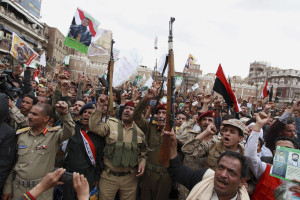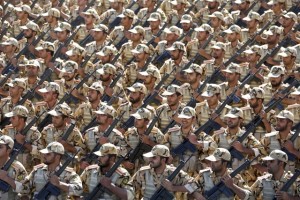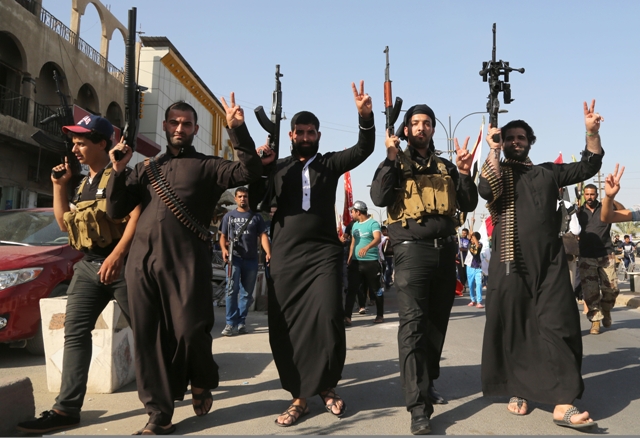According to the US State Department, Islamic terror increased over the past year, with Iran serving as one of the primary instigators – all while negotiating with world powers over its nuclear program.
By: AP and World Israel News Staff


Iranian-sponsored Shiite rebels, known as Houthis, in Yemen.(AP/Hani Mohammed)
Iran’s support for international terror groups remained undiminished last year and even expanded in some respects, the Obama administration said Friday, less than two weeks before the deadline for completing a nuclear agreement. The deal could provide Tehran with billions of dollars in relief from economic sanctions, which likely will be invested in its global terror network.
The assessment offered a worrying sign of even worse terror-related violence to come after a year in which terrorists in the Middle East, Africa and Asia committed 35 percent more terror acts, killed nearly twice as many people and almost tripled the number of kidnappings worldwide.
Statistics released by the State Department on Friday also pointed to a tenfold surge in the most lethal kinds of attacks.
Yet even as the Islamic State (ISIS) terror group and the Taliban were blamed for most of the death and destruction in 2014, the department’s annual terrorism report underscored the ongoing threat posed by Iran and its proxies across the Islamic world and beyond.
Tehran increased its assistance to Shiite militias fighting in Iraq and Yemen and continued its long-standing military, intelligence and financial aid to Lebanon’s Hezbollah terror organization, Syrian President Bashar Assad’s embattled government and Palestinian terror groups Hamas and Islamic Jihad.
While the study said Iran has lived up to interim nuclear deals with world powers thus far, it gave no prediction about how an Iran flush with cash from a final agreement would behave.
World powers and Iran are trying to conclude an accord by the end of the month, setting at least 10 years of restrictions on Iran’s nuclear program in exchange for significant relief from the international sanctions that have crippled the Iranian economy.


Iran’s army on parade. (AP/Ebrahim Noroozi)
The Obama administration had avoided touching on Iran’s support for terror groups beyond its border in the negotiations. Israel and the Sunni monarchies of the Persian Gulf, Iran’s regional rivals, fear a fresh wave of terrorism as a result of any pact. President Barack Obama, hoping to ease their fears, has said most of the money would go to Iran’s economic development.
America’s “grave concern about Iran’s support for terrorism remains unabated,” White House spokesman Eric Shultz said. “That is all the more reason that we need to make sure they don’t obtain a nuclear weapon.”
Interestingly enough, an annual US security report on global terror threats prepared by Director of National Intelligence James Clapper in April did not include Iran or Hezbollah.
“Iran is a terrorist monster that funds, trains and arms organizations and entities to wreak havoc among the pro-Western regimes in the Middle East and around the world, and it has no intention of stopping this,” Defense Minister Moshe Ya’alon warned in April.
Iran is sponsoring terrorism across the globe, is conducting “an unprecedented conventional arms build-up,” and is doing all this without nuclear weapons. ”Think of what Iran would do tomorrow with nuclear weapons,” Prime Minister Benjamin Netanyahu stated in June.
33,000 victims in 13,500 attacks
ISIS terrorists in prayer. (barnabasfund.org)
In total, there was a 35 percent increase in 2014 in the number of attacks, with 81 percent more fatalities, according to the State Department report. Terrorists carried out 13,463 attacks, resulting in 32,700 victims. That’s up from just over 18,000 deaths in nearly 10,000 attacks in 2013.
Abductions soared to 9,428 in the calendar year from 3,137 in 2013.
The report attributes the rise in attacks to increased terror activity in Iraq, Afghanistan and Nigeria, and the sharp spike in deaths to a growth in exceptionally lethal attacks in those countries and elsewhere.
There were 20 attacks that killed more than 100 people each in 2014, compared to just two a year earlier, the report said. Among those were December’s attack by the Pakistani Taliban on a school in Peshawar that killed at least 150 people and the June attack by ISIS terrorists on a prison in Mosul, Iraq, in which 670 Shiite prisoners died.
At the end of 2014, the prison attack was the deadliest terrorist operation in the world since September. 11, 2001, according to the report.
Despite all indications pointing toward increased violence, the State Department’s counterterrorism coordinator said the numbers did not reflect improvements by the US and its partners in stamping out terrorism financing, improving information sharing, impeding foreign fighters and forming a coalition to fight ISIS. “We have made progress,” Ambassador Tina Kaidanow had said.
Attacks occurred in 95 countries last year but were concentrated in the Mideast, South Asia and West Africa. Iraq, Pakistan, Afghanistan, India and Nigeria accounted for more than 60 percent of the attacks. Adding Syria, they comprised roughly 80 percent of the fatalities, the report found.
ISIS executes prisoners. (Dabiq)
The rise in kidnappings is mainly attributable to the mass abductions by terrorist groups in Syria, notably by ISIS and the al-Qaida-linked al-Nusra Front.
In Nigeria, Boko Haram was responsible for most, if not all, of the nearly 1,300 abductions, including several hundred girls from a school in Chibok. By contrast, the report cited fewer than 100 terror-related kidnappings reported in Nigeria in 2013.
Friday’s report noted the “unprecedented seizure” of territory in Iraq and Syria by the Islamic State group, its ability to recruit foreign fighters to join its cause and the emergence of self-proclaimed affiliates, notably in Libya, Egypt and Nigeria. It cited a rise in so-called lone wolf attacks in the West and terrorists employing more extreme methods of violence to repress and frighten communities under their control.

